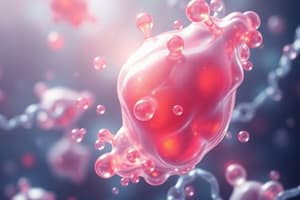Podcast
Questions and Answers
What is a potential health concern associated with trans fats?
What is a potential health concern associated with trans fats?
- Lowering insulin sensitivity
- Reducing inflammation
- Increasing absorption of vitamins
- Raising cholesterol levels (correct)
How do genetic factors influence lipid levels?
How do genetic factors influence lipid levels?
- They can predispose individuals to lipid metabolism disorders. (correct)
- They only affect triglyceride levels.
- They have no impact on lipid levels.
- They solely determine dietary choices.
Which of the following is a purpose of clinical tests for lipid levels?
Which of the following is a purpose of clinical tests for lipid levels?
- To determine medication dosages
- To diagnose conditions and monitor treatment effectiveness (correct)
- To measure blood glucose levels
- To compare genetic sequences
What is a key reason for understanding lipid metabolism?
What is a key reason for understanding lipid metabolism?
Which of the following disorders is associated with elevated lipid levels?
Which of the following disorders is associated with elevated lipid levels?
What type of fatty acids cannot be synthesized by the body and must be obtained from the diet?
What type of fatty acids cannot be synthesized by the body and must be obtained from the diet?
Which of the following is a major form of energy storage in the body?
Which of the following is a major form of energy storage in the body?
What structural feature characterizes phospholipids?
What structural feature characterizes phospholipids?
What is the role of cholesterol in the phospholipid bilayer of cell membranes?
What is the role of cholesterol in the phospholipid bilayer of cell membranes?
Unsaturated fatty acids differ from saturated fatty acids primarily due to what characteristic?
Unsaturated fatty acids differ from saturated fatty acids primarily due to what characteristic?
Which type of lipids are important components of nerve tissue?
Which type of lipids are important components of nerve tissue?
Which statement about saturated fatty acids is correct?
Which statement about saturated fatty acids is correct?
What characteristic feature do waxes have that makes them functionally significant?
What characteristic feature do waxes have that makes them functionally significant?
Flashcards
Trans fats vs. Unsaturated fats
Trans fats vs. Unsaturated fats
Trans fats have a different structure than naturally occurring unsaturated fats, and may raise health concerns.
Elevated lipids
Elevated lipids
High levels of cholesterol and triglycerides increase heart disease risk.
Lipid disorders
Lipid disorders
Problems with how your body processes fats, leading to health problems like high lipids.
Lipid tests
Lipid tests
Signup and view all the flashcards
Lipid profiles
Lipid profiles
Signup and view all the flashcards
Lipid Classification
Lipid Classification
Signup and view all the flashcards
Fatty Acid
Fatty Acid
Signup and view all the flashcards
Triglyceride
Triglyceride
Signup and view all the flashcards
Phospholipid
Phospholipid
Signup and view all the flashcards
Steroid
Steroid
Signup and view all the flashcards
Cell Membrane Structure
Cell Membrane Structure
Signup and view all the flashcards
Saturated Fatty Acid
Saturated Fatty Acid
Signup and view all the flashcards
Essential Fatty Acid
Essential Fatty Acid
Signup and view all the flashcards
Study Notes
Lipids
- Lipids are a diverse group of hydrophobic molecules, insoluble in water.
- They are crucial for cell structure, energy storage, hormone production, and vitamin absorption.
- Lipids include fats, oils, waxes, steroids, and phospholipids.
- They are an important source of energy for the body.
Lipid Classification
- Lipids are classified in several ways based on their structure and function.
- Fatty Acids:
- Long-chain carboxylic acids.
- Saturated (no double bonds) or unsaturated (one or more double bonds).
- Unsaturated fatty acids can be monounsaturated or polyunsaturated.
- Essential fatty acids (e.g., linoleic acid, linolenic acid) cannot be synthesized by the body and must be obtained from the diet.
- Triglycerides:
- Three fatty acid chains esterified to a glycerol molecule.
- Major form of energy storage in the body.
- Phospholipids:
- Contain a glycerol backbone, two fatty acid chains, and a phosphate group.
- Important components of cell membranes.
- Sphingolipids:
- Contain a sphingosine backbone instead of glycerol.
- Important components of cell membranes and nerve tissue.
- Steroids:
- Four fused carbon rings.
- Include cholesterol, hormones (e.g., estrogen, testosterone), and bile acids.
- Waxes:
- Esters of long-chain fatty acids and long-chain alcohols.
- Provide waterproofing in plants and animals.
Membrane Structure
- Cell membranes are primarily composed of phospholipids arranged in a bilayer.
- The hydrophobic tails of the phospholipids face inward, while the hydrophilic heads face outward towards the aqueous environment.
- Cholesterol is embedded within the phospholipid bilayer, influencing membrane fluidity and permeability.
- Membrane proteins are also embedded in the bilayer, performing various functions such as transport, signaling, and enzymatic activity.
- Membrane fluidity depends on temperature, fatty acid saturation, and cholesterol content.
Fatty Acids
- Fatty acids are crucial components of lipids.
- Determining their structure is important in evaluating their potential health implications.
- Saturated fatty acids are typically solid at room temperature, while unsaturated fatty acids are typically liquid.
- The presence of double bonds influences the physical properties, stability, and potential health effects of the fatty acid.
- Essential fatty acids (EFAs) are crucial for various body functions and cannot be produced by the body.
- Trans fats, found in processed foods, have a different structure than naturally occurring unsaturated fats, potentially raising health concerns.
Clinical Significance of Lipids
- Elevated levels of lipids, particularly cholesterol and triglycerides, can increase the risk of cardiovascular disease.
- Disorders of lipid metabolism can lead to various health problems, including hyperlipidemia.
- Clinical tests assess lipid levels to diagnose conditions and monitor treatment effectiveness.
- Genetic factors and dietary habits influence lipid levels.
- Understanding lipid metabolism and its associated disorders is critical for preventive and therapeutic measures.
- Lipid profiles are essential for assessing cardiovascular risks.
- Lipid disorders can manifest in different ways depending on the specific lipid being affected.
- Different diets and lifestyle interventions influence lipid levels, therefore understanding lipid metabolism is critical for dietary recommendations.
Studying That Suits You
Use AI to generate personalized quizzes and flashcards to suit your learning preferences.



